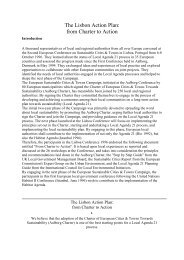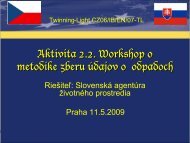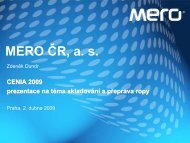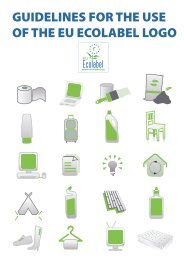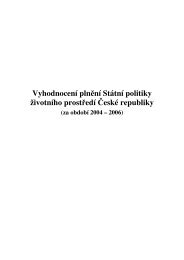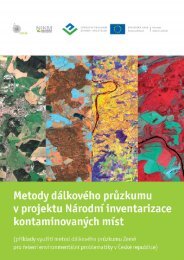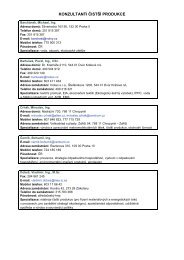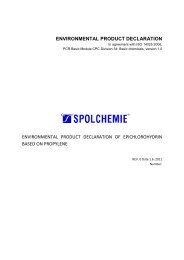Environmental Technologies and Eco-innovation in the Czech ...
Environmental Technologies and Eco-innovation in the Czech ...
Environmental Technologies and Eco-innovation in the Czech ...
Create successful ePaper yourself
Turn your PDF publications into a flip-book with our unique Google optimized e-Paper software.
6.5 | Modern physical methods <strong>in</strong> <strong>the</strong> waste<br />
water treatment technology<br />
Filtration is <strong>the</strong> most-used physical technology <strong>in</strong> waste water treatment; its<br />
use is possible on several levels. In <strong>the</strong> f<strong>in</strong>al waste water treatment, it is possible to<br />
use both common filtration on s<strong>and</strong> <strong>and</strong> mixed filters, as well as pressure filtration<br />
on microstra<strong>in</strong>ers <strong>and</strong> micro to ultrafiltration on membranes. All <strong>the</strong> mentioned<br />
technologies are used to remove <strong>the</strong> residual concentrations of undissolved<br />
substances <strong>in</strong> <strong>the</strong> discharge by capture on <strong>the</strong> filtration medium. Lower<strong>in</strong>g <strong>the</strong><br />
concentration of undissolved substances will also cause improved discharge<br />
concentrations of o<strong>the</strong>r pollution <strong>in</strong>dicators (total nitrogen, total phosphorus,<br />
COD Cr ). With this technology, it is always necessary to take account of <strong>the</strong> regeneration<br />
of <strong>the</strong> filter (<strong>the</strong> filtration bed) <strong>and</strong> of <strong>the</strong> disposal of <strong>the</strong> water used for this activity.<br />
Sorption, as ano<strong>the</strong>r method of f<strong>in</strong>al tertiary waste water treatment, works on<br />
<strong>the</strong> pr<strong>in</strong>ciple of accumulat<strong>in</strong>g (capture) <strong>the</strong> dissolved substances on <strong>the</strong> surface of<br />
<strong>the</strong> solid phase (adsorbent); <strong>the</strong> base material. Activated carbon is most often used<br />
as an adsorbent <strong>in</strong> <strong>the</strong> technology (powder or granulated). However, o<strong>the</strong>r sorption<br />
materials may be used, such as fly-ash, cl<strong>in</strong>ker, bentonites <strong>and</strong> organic polymer<br />
substances (styrene <strong>and</strong> div<strong>in</strong>ylbenzene copolymers, acrylic acid esters). It is possible<br />
to <strong>in</strong>tensify <strong>the</strong> filtration process by <strong>the</strong> adsorbent layer <strong>and</strong> by filtration bed’s<br />
surface. The sorption process is <strong>in</strong>fluenced by a number of factors <strong>in</strong>clud<strong>in</strong>g <strong>the</strong> size of<br />
adsorbent particles, <strong>the</strong> adsorbate concentration, temperature, pH, molecular weight<br />
<strong>and</strong> o<strong>the</strong>r specific properties of <strong>the</strong> substance be<strong>in</strong>g absorbed. Sorption is used to<br />
remove carc<strong>in</strong>ogenic <strong>and</strong> mutagenic substances, substances that are biologically<br />
degradable with difficulty or malodorous substances. These ma<strong>in</strong>ly <strong>in</strong>clude residual<br />
concentrations of organic substances (chlor<strong>in</strong>ated aromatic hydrocarbons, pesticides),<br />
heavy metals, free chlor<strong>in</strong>e, etc. The regeneration <strong>and</strong> removal of exhausted sorbents<br />
may become a problematic issue of this technology.<br />
The technology of electric-impulsion waste water treatment is a less-thanst<strong>and</strong>ard<br />
technology mak<strong>in</strong>g use of <strong>the</strong> reaction of water to electric current. This<br />
technology is characterized by high efficiency <strong>in</strong> reduc<strong>in</strong>g carbon pollution,<br />
elim<strong>in</strong>at<strong>in</strong>g nutrients <strong>and</strong> <strong>in</strong> remov<strong>in</strong>g undesirable substances, such as greases,<br />
degreas<strong>in</strong>g agents, crude oil <strong>and</strong> oil products. The pr<strong>in</strong>ciple of <strong>the</strong> operation is that<br />
strong electric <strong>and</strong> magnetic fields affect <strong>the</strong> cont<strong>in</strong>uous flow of polluted water. In this<br />
process, dissociation of <strong>the</strong> molecules 19 of <strong>the</strong> substances conta<strong>in</strong>ed <strong>in</strong> <strong>the</strong> waste water<br />
occurs because of <strong>the</strong> action of <strong>the</strong> impulsion electromagnetic field. A consequence is<br />
19 dissociation of molecules – divid<strong>in</strong>g a compound’s molecules <strong>in</strong>to separate ions




